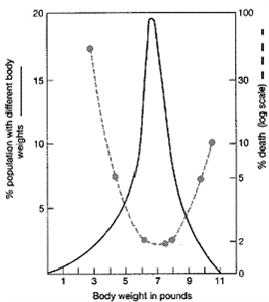Microfilaments:
A) help cells move or capture prey.
B) act as "monorails" along which organelles move.
C) form the structure of cilia and flagella.
D) stabilize the position of the nucleus.
Answer: A
You might also like to view...
According to the endosymbiont hypothesis, ____
a. most of the genes from the endocytosed bacteria moved to the nucleus
b. the host anaerobe became dependent upon the endocytosed bacteria c. the endocytosized bacteria became dependent on the host cell d. all endocytosed bacteria were photosynthetic e. most of the genes from the endocytosed bacteria moved to the nucleus, the host anaerobe became dependent upon the endocytosed bacteria, and the endocytosed bacteria became dependent on the host cell
Based on the data in the accompanying figure, the infant with the highest probability of survival would weigh:

a. 11 lbs.
b. 9 lbs.
c. 7 lbs.
d. 5 lbs.
e. 3 lbs.
The mammalian lineages include
A. monotremes. B. marsupials. C. placental mammals. D. All of the answer choices are correct. E. No answer choice is correct.
The fossil record used to support evolution is not complete. In fact, large gaps exist in the fossil record. As a result, the evolution of a species cannot be completely traced in many cases. What is one reason why the fossil record is incomplete?
A) Fossils can form only from the remains of complex organisms. B) Many species lived in environments that did not favor fossil formation. C) The fossil record only contains the fossils of land organisms. D) Fossils can survive only for 10,000 years.